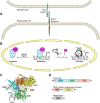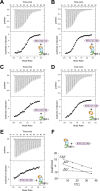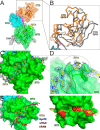Structure-function analysis of RBP-J-interacting and tubulin-associated (RITA) reveals regions critical for repression of Notch target genes
- PMID: 28487372
- PMCID: PMC5481562
- DOI: 10.1074/jbc.M117.791707
Structure-function analysis of RBP-J-interacting and tubulin-associated (RITA) reveals regions critical for repression of Notch target genes
Abstract
The Notch pathway is a cell-to-cell signaling mechanism that is essential for tissue development and maintenance, and aberrant Notch signaling has been implicated in various cancers, congenital defects, and cardiovascular diseases. Notch signaling activates the expression of target genes, which are regulated by the transcription factor CSL (CBF1/RBP-J, Su(H), Lag-1). CSL interacts with both transcriptional corepressor and coactivator proteins, functioning as both a repressor and activator, respectively. Although Notch activation complexes are relatively well understood at the structural level, less is known about how CSL interacts with corepressors. Recently, a new RBP-J (mammalian CSL ortholog)-interacting protein termed RITA has been identified and shown to export RBP-J out of the nucleus, thereby leading to the down-regulation of Notch target gene expression. However, the molecular details of RBP-J/RITA interactions are unclear. Here, using a combination of biochemical/cellular, structural, and biophysical techniques, we demonstrate that endogenous RBP-J and RITA proteins interact in cells, map the binding regions necessary for RBP-J·RITA complex formation, and determine the X-ray structure of the RBP-J·RITA complex bound to DNA. To validate the structure and glean more insights into function, we tested structure-based RBP-J and RITA mutants with biochemical/cellular assays and isothermal titration calorimetry. Whereas our structural and biophysical studies demonstrate that RITA binds RBP-J similarly to the RAM (RBP-J-associated molecule) domain of Notch, our biochemical and cellular assays suggest that RITA interacts with additional regions in RBP-J. Taken together, these results provide molecular insights into the mechanism of RITA-mediated regulation of Notch signaling, contributing to our understanding of how CSL functions as a transcriptional repressor of Notch target genes.
Keywords: Notch pathway; X-ray crystallography; gene regulation; isothermal titration calorimetry (ITC); protein-protein interaction; signal transduction; transcription corepressor; transcription factor.
© 2017 by The American Society for Biochemistry and Molecular Biology, Inc.
Conflict of interest statement
The authors declare that they have no conflicts of interest with the contents of this article
Figures








Similar articles
-
Thermodynamic binding analysis of Notch transcription complexes from Drosophila melanogaster.Protein Sci. 2015 May;24(5):812-22. doi: 10.1002/pro.2652. Epub 2015 Mar 16. Protein Sci. 2015. PMID: 25650119 Free PMC article.
-
Transcriptional repression in the Notch pathway: thermodynamic characterization of CSL-MINT (Msx2-interacting nuclear target protein) complexes.J Biol Chem. 2011 Apr 29;286(17):14892-902. doi: 10.1074/jbc.M110.181156. Epub 2011 Mar 3. J Biol Chem. 2011. PMID: 21372128 Free PMC article.
-
Structural and Functional Studies of the RBPJ-SHARP Complex Reveal a Conserved Corepressor Binding Site.Cell Rep. 2019 Jan 22;26(4):845-854.e6. doi: 10.1016/j.celrep.2018.12.097. Cell Rep. 2019. PMID: 30673607 Free PMC article.
-
CSL-Associated Corepressor and Coactivator Complexes.Adv Exp Med Biol. 2018;1066:279-295. doi: 10.1007/978-3-319-89512-3_14. Adv Exp Med Biol. 2018. PMID: 30030832 Review.
-
Notch-independent functions of CSL.Curr Top Dev Biol. 2011;97:55-74. doi: 10.1016/B978-0-12-385975-4.00009-7. Curr Top Dev Biol. 2011. PMID: 22074602 Review.
Cited by
-
OPTHiS Identifies the Molecular Basis of the Direct Interaction between CSL and SMRT Corepressor.Mol Cells. 2018 Sep 30;41(9):842-852. doi: 10.14348/molcells.2018.0196. Epub 2018 Aug 30. Mol Cells. 2018. PMID: 30157580 Free PMC article.
-
Colon cancer cells secreted CXCL11 via RBP-Jκ to facilitated tumour-associated macrophage-induced cancer metastasis.J Cell Mol Med. 2021 Nov;25(22):10575-10590. doi: 10.1111/jcmm.16989. Epub 2021 Oct 16. J Cell Mol Med. 2021. PMID: 34655278 Free PMC article.
-
CK1 Is a Druggable Regulator of Microtubule Dynamics and Microtubule-Associated Processes.Cancers (Basel). 2022 Mar 5;14(5):1345. doi: 10.3390/cancers14051345. Cancers (Basel). 2022. PMID: 35267653 Free PMC article. Review.
-
SUMOylated non-canonical polycomb PRC1.6 complex as a prerequisite for recruitment of transcription factor RBPJ.Epigenetics Chromatin. 2021 Jul 31;14(1):38. doi: 10.1186/s13072-021-00412-9. Epigenetics Chromatin. 2021. PMID: 34332624 Free PMC article.
-
The Binding of CSL Proteins to Either Co-Activators or Co-Repressors Protects from Proteasomal Degradation Induced by MAPK-Dependent Phosphorylation.Int J Mol Sci. 2022 Oct 15;23(20):12336. doi: 10.3390/ijms232012336. Int J Mol Sci. 2022. PMID: 36293193 Free PMC article.
References
-
- Bray S. J. (2016) Notch signalling in context. Nat. Rev. Mol. Cell Biol. 17, 722–735 - PubMed
-
- Swiatek P. J., Lindsell C. E., del Amo F. F., Weinmaster G., and Gridley T. (1994) Notch1 is essential for postimplantation development in mice. Genes Dev. 8, 707–719 - PubMed
-
- Gridley T. (2003) Notch signaling and inherited disease syndromes. Hum. Mol. Genet. 12, R9–R13 - PubMed
-
- Koch U., and Radtke F. (2010) Notch signaling in solid tumors. Curr. Top. Dev. Biol. 92, 411–455 - PubMed
Publication types
MeSH terms
Substances
Associated data
- Actions
- Actions
- Actions
- Actions
- Actions
- Actions
- Actions
- Actions
Grants and funding
LinkOut - more resources
Full Text Sources
Other Literature Sources
Molecular Biology Databases

